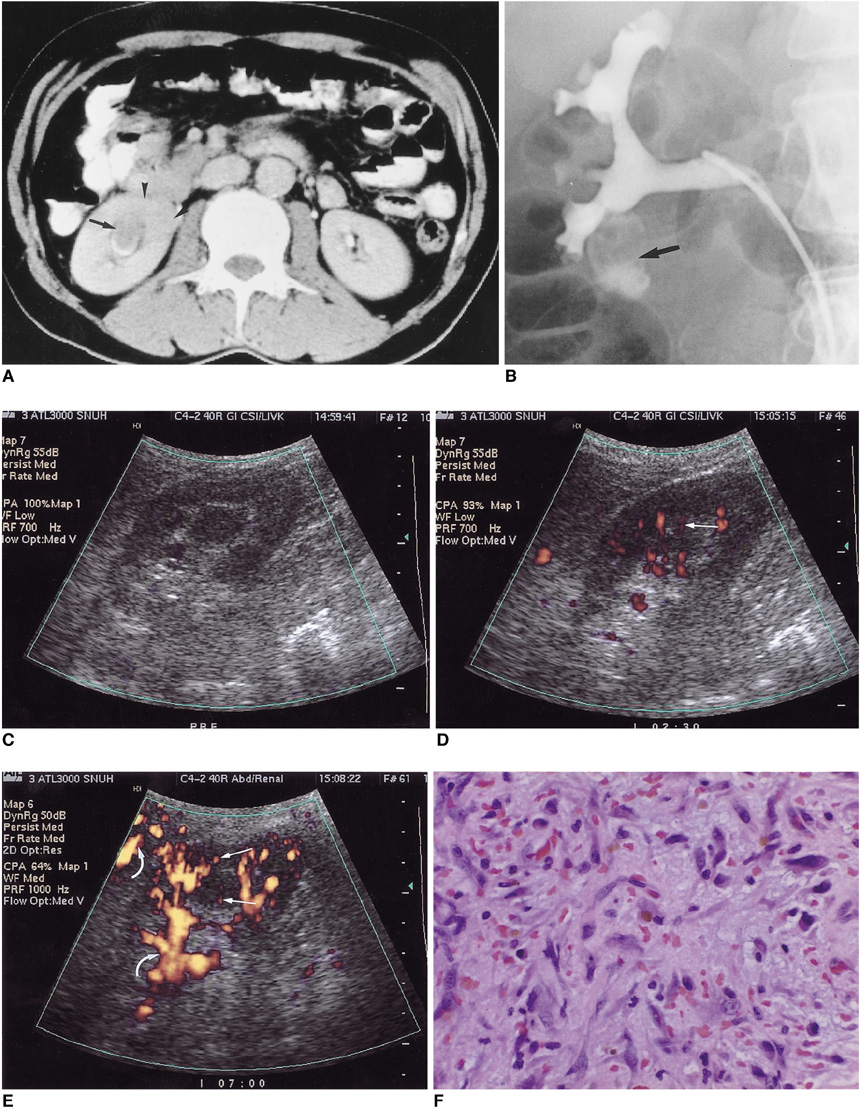Korean J Radiol.
2000 Dec;1(4):219-222. 10.3348/kjr.2000.1.4.219.
Radiologic Findings of Renal Inflammatory Pseudotumor: A Case Report
- Affiliations
-
- 1Department of Radiology, Seoul National University College of Medicine, Seoul, Korea.
- KMID: 1378949
- DOI: http://doi.org/10.3348/kjr.2000.1.4.219
Abstract
- Renal inflammatory pseudotumor is a very rare benign condition of unknown etiology characterized by proliferative myofibroblasts, fibroblasts, histiocytes, and plasma cells. In the case we report, the lesion appeared on contrast-enhanced power Doppler US images as a well-defined hypoechoic mass with intratumoral vascularity, and on CT as a low-attenuated mass. Differentiation from malignant renal neoplasms was not possible.
Keyword
MeSH Terms
Figure
Reference
-
1. Horiuchi R, Uchida T, Kojima T, et al. Inflammatory pseudotumor of the liver: Clinicopathologic study and review of the literature. Cancer. 1990. 65:1583–1590.2. Bell ND, Gavras JN, Donnell CA, Rodning CB. Renal inflammatory pseudotumor. South Med J. 1998. 91:1050–1053.3. Vujanic GM, Berry PJ, Frank JD. Inflammatory pseudotumor of the kidney with extensive metaplastic bone. Pediatr Pathol. 1992. 12:557–561.4. Young RH, Scully RE. Pseudosarcomatous lesions of the urinary bladder, prostate gland, and urethra: A report of three cases and review of the literature. Arch Pathol Lab Med. 1987. 111:354–358.5. Jones EC, Clement PB, Young RH. Inflammatory pseudotumor of the urinary bladder: A clinicopathological, immunohistochemical, ultrastructural, and flow cytometric study of 13 cases. Am J Surg Pathol. 1993. 17:264–274.6. Materne R, Van Beers BE, Gigot JF, et al. Inflammatory pseudotumor of the liver: MRI with mangafodipir trisodium. J Comput Assist Tomogr. 1998. 22:82–84.7. Abehsera M, Vilgrain V, Belghiti J, Flejou JF, Nahum H. Inflammatory pseudotumor of the liver: radiologic-pathologic correlation. J Comput Assist Tomogr. 1995. 19:80–83.8. Nam KJ, Kang HK, Lim JH. Inflammatory pseudotumor of the liver: CT and sonographic findings. AJR. 1996. 167:485–487.9. Kim AY, Kim SH, Kim YJ, et al. Contrast-enhanced power Doppler sonography for the differentiation of cystic renal lesions: preliminary study. J Ultrasound Med. 1999. 18:581–588.10. Choi BI, Kim TK, Han JK, et al. Vascularity of hepatocellular carcinoma: assessment with contrast-enhanced second-harmonic versus conventional power Doppler US. Radiology. 2000. 214:381–386.


